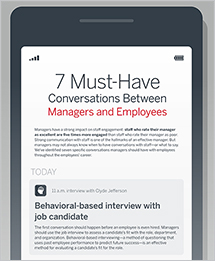Editor's note: This popular story from the Daily Briefing's archives was republished on May 17, 2019.
It can be difficult to deal with two-faced colleagues—that is, coworkers who act differently one-on-one than they do when the boss is in the room.
Writing for the Harvard Business Review, Amy Jen Su identifies three distinct types of two-faced colleagues and what you can do to better manage each one.
1. 'All that jazz'
Jen Su describes these colleagues as "fast-talking, articulate, and quick on their feet." They appear motivated and engaged when the boss is in the room, yet when the boss is not present, these colleagues tend to slack off or contribute less work to a project than others.
How to respond to your colleague: Ask for clarification about how your team is dividing up a project, and request to discuss it in the next meeting.
How to respond to your boss: Request a three-way meeting to establish roles and responsibilities before the next project.
2. 'Sugar and spice'
Sugar-and-spice colleagues are open and amicable in person, but they undermine you in private to the boss. Jen Su quotes a description of this type of colleague by Karen Dillon, author of the HBR Guide to Office Politics: "[This colleague] applauds your efforts when the boss is in the room, and then behind the scenes, you learn that she has quietly gone to the boss afterward to express her concerns."
How to respond to your colleague: Request that next time, your colleague come to you directly with concerns. Mention that you've heard about the concerns your colleague shared with your boss.
How to respond to your boss: Thank your boss for sharing your colleague's concerns, and ask to be kept in the loop about similar concerns going forward. Request that your boss encourage the colleague to come to you directly.
3. 'Classic Machiavelli'
Jen Su says this kind of colleague will act rude and dismissive to you in person, yet respectful and charming in the presence of the boss.
"This person is on his best behavior around people who can help him fulfill his ambitions," writes Jen Su. Machiavellian colleagues are all about making excellent impressions on their superiors, while harshly controlling their subordinates.
How to respond to your colleague: Acknowledge that you have sensed your colleague's frustration, and request that the colleague let you know what would help alleviate the tension. Emphasize the need for a collaborative tone going forward.
How to respond to your boss: Inform your boss of your colleague's frustrated tone, and ask for guidance about how to better understand your colleague's priorities.
For all three types
First, remind yourself that your colleague's behavior likely stems from something in his or her own life—it is not about you. The person may be insecure about work or may have grown up in an environment where it was necessary to act this way to get ahead.
Jen Su cites an explanation from Dillon: "Rarely is [this behavior] about evil intentions—it's usually due to a lack of awareness or ineptness in emotional intelligence."
Next, refrain from exhibiting this same behavior back to the colleague. Jen Su says it is never constructive to "fight fire with fire."
Finally, ask yourself whether the colleague's behavior is actually detrimental to your team's productivity. "Make [the conflict] about you being a better colleague, not about punishing them for not being the same," Jen Su says.
If the behavior is affecting the team's work, it may be time to have a conversation—preferably in private—with your colleague. If the conversation does not initiate a change in behavior, then it could be time to discuss the matter with your boss (Jen Su, Harvard Business Review, 11/22).
Dealing with difficult colleagues in meetings? Our infographic can help.
There are about 11 million formal meetings in the United States every day—and more than half of them may be unproductive. Why? Because many meetings are inefficiently run. They don't set or achieve clear goals. And we hold them out of habit.
Drawing on best practices—as well as lessons from across our own organization—we've created this useful infographic to guide if you really need a meeting (and if so, how to maximize everyone's time).
Don't miss out on the latest Advisory Board insights
Create your free account to access 1 resource, including the latest research and webinars.
Want access without creating an account?
You have 1 free members-only resource remaining this month.
1 free members-only resources remaining
1 free members-only resources remaining
You've reached your limit of free insights
Become a member to access all of Advisory Board's resources, events, and experts
Never miss out on the latest innovative health care content tailored to you.
Benefits include:
You've reached your limit of free insights
Become a member to access all of Advisory Board's resources, events, and experts
Never miss out on the latest innovative health care content tailored to you.
Benefits include:
This content is available through your Curated Research partnership with Advisory Board. Click on ‘view this resource’ to read the full piece
Email ask@advisory.com to learn more
Click on ‘Become a Member’ to learn about the benefits of a Full-Access partnership with Advisory Board
Never miss out on the latest innovative health care content tailored to you.
Benefits Include:
This is for members only. Learn more.
Click on ‘Become a Member’ to learn about the benefits of a Full-Access partnership with Advisory Board
Never miss out on the latest innovative health care content tailored to you.



